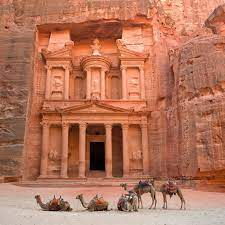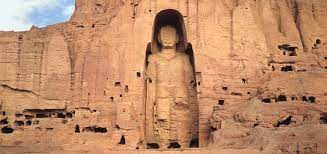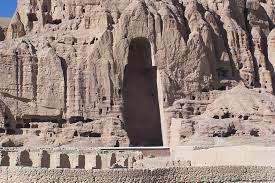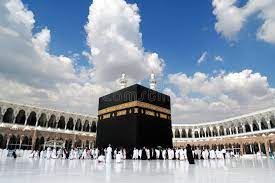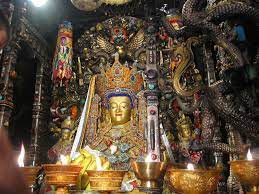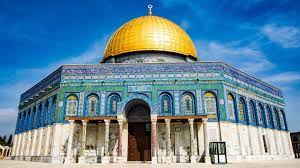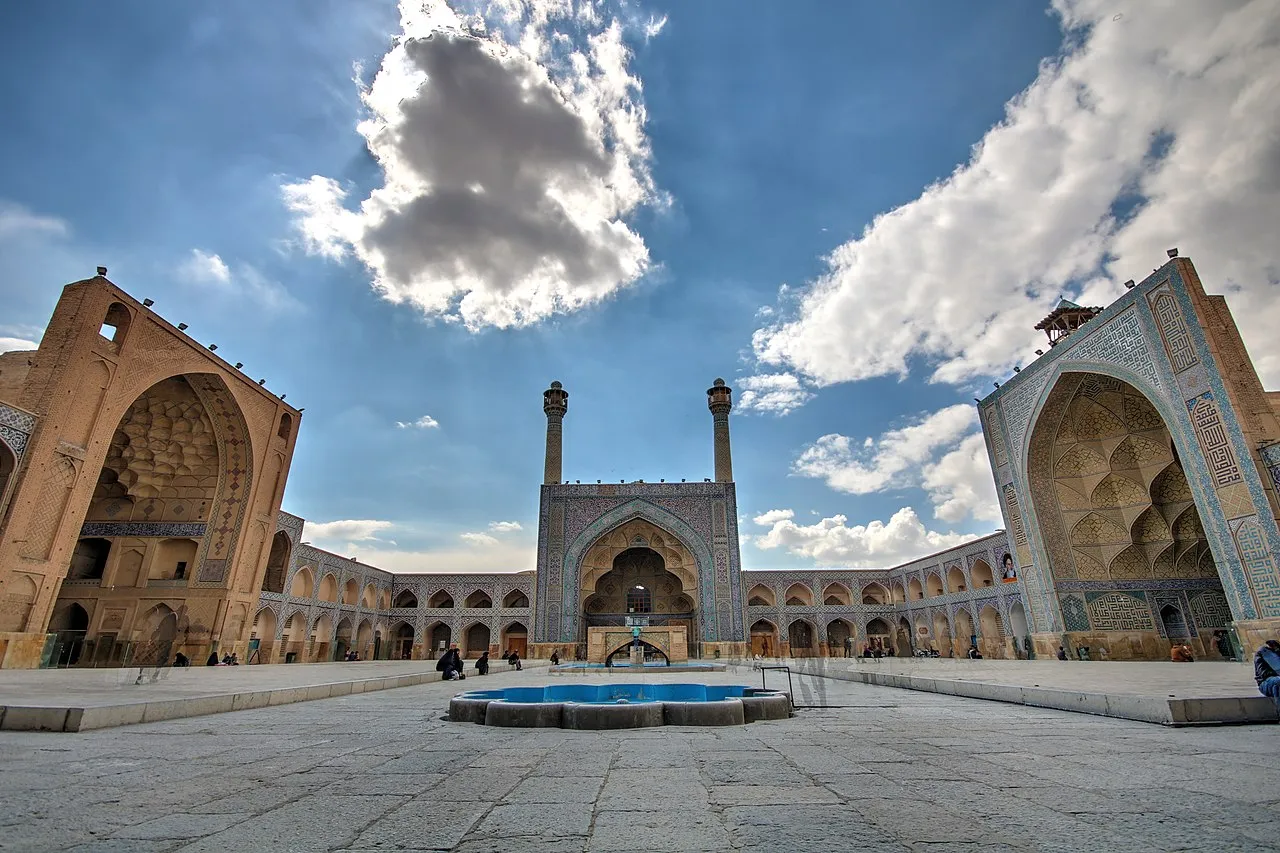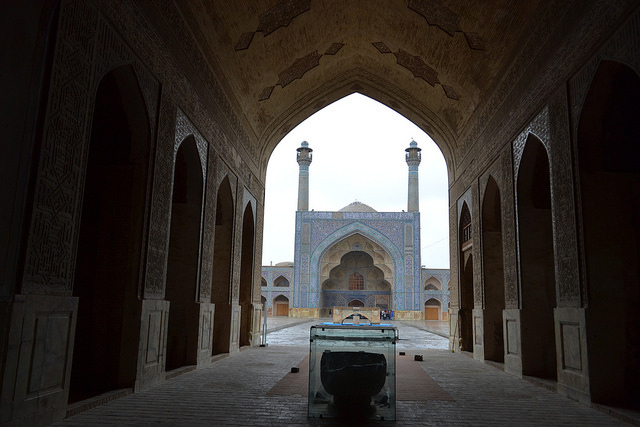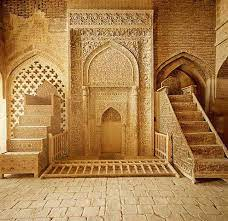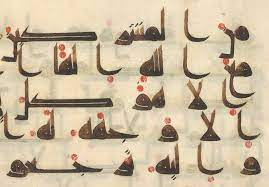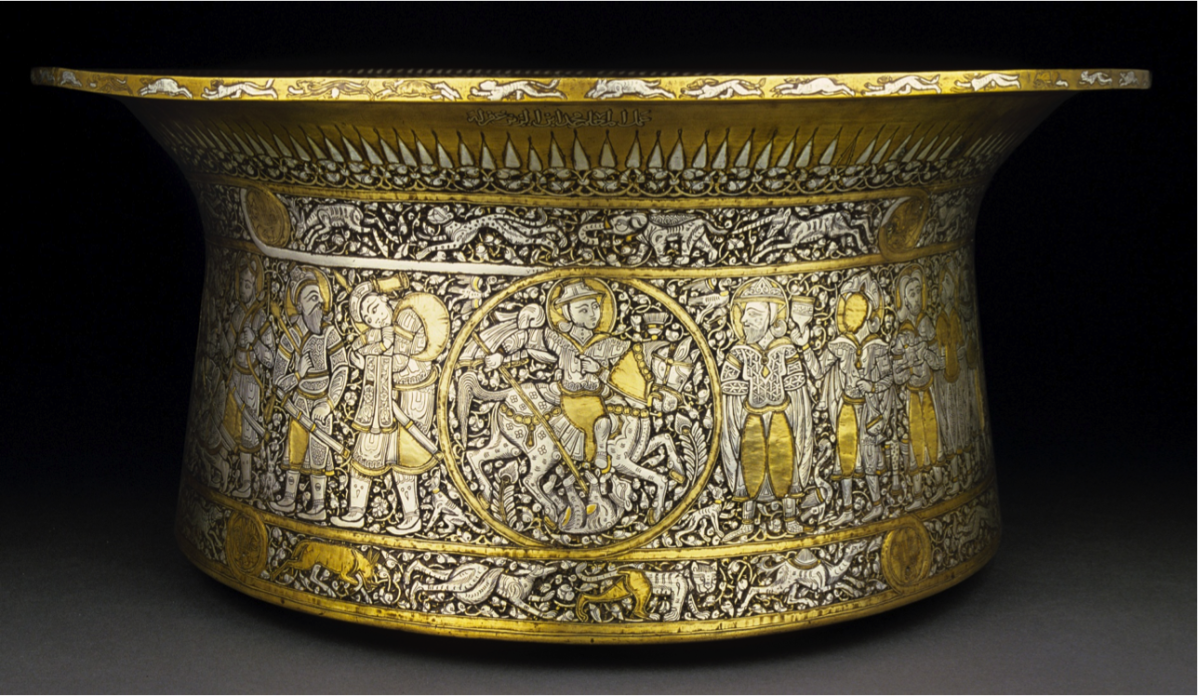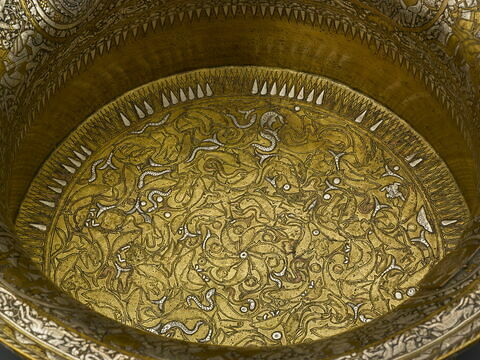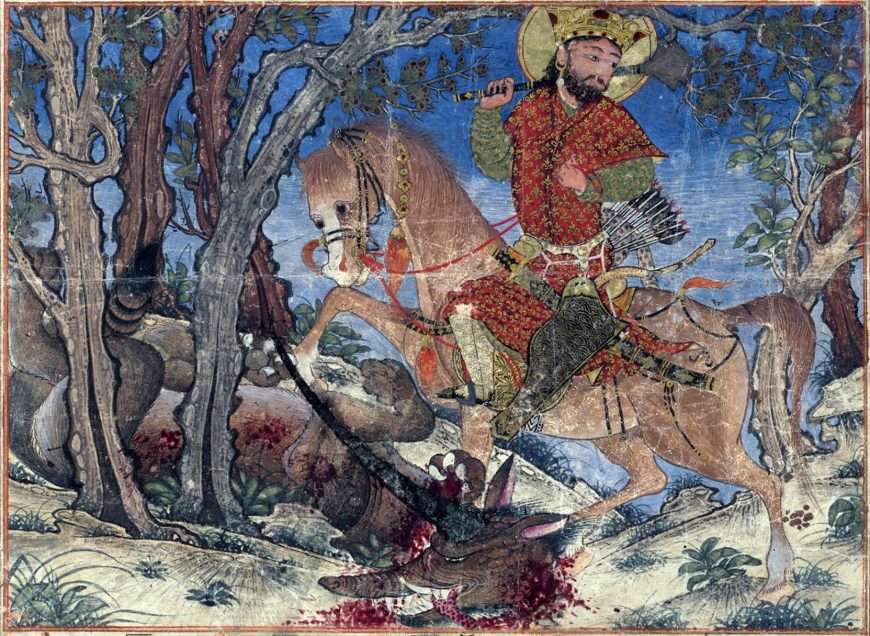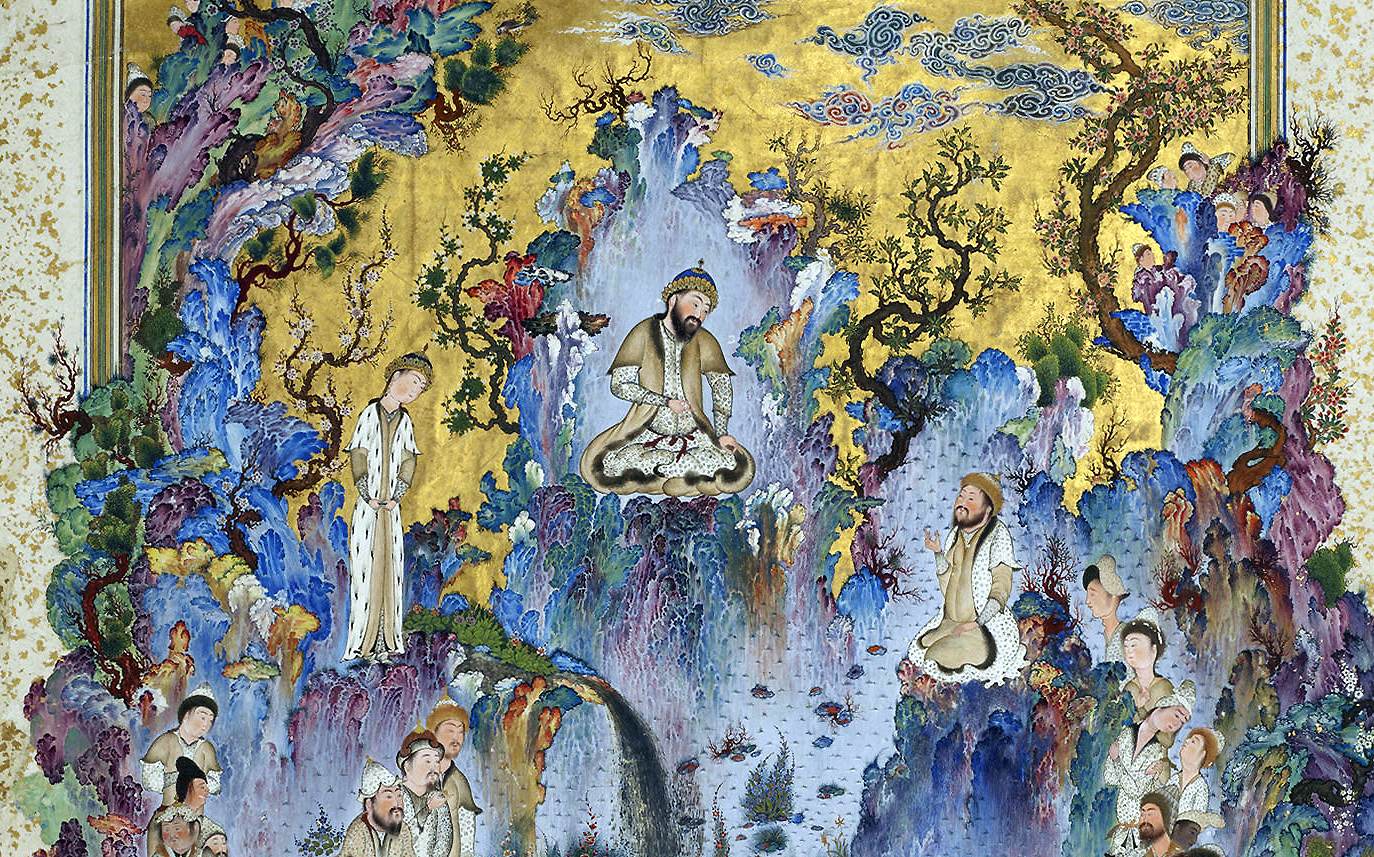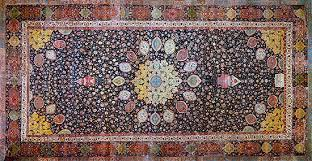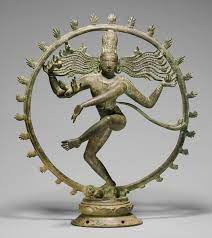
West Central Asia - AP Art History 🕋
Islamic Religion
both the Christians and the Islamics both share the Old Testament.
words to know:
Arabesque: an ornamental design consisting of intertwined flowing lines, originally found in Arabic or Moorish decoration.
Dome of the Rock: an Islamic shrine located on the Temple Mount in the Old City of Jerusalem.
Great Mosque of Cordoba: Known locally as Mezquita-Catedral, the Great Mosque of Córdoba is one of the oldest structures still standing from the time Muslims ruled Al-Andalus (Muslim Iberia including most of Spain, Portugal, and a small section of Southern France) in the late 8th century.
Iwan: a large hall or audience chamber often open on one side and found in Parthian architecture.
Kufic Script: a style of Arabic script that gained prominence early on as a preferred script for Quran transcription.
Mihrab: a niche in the wall of a mosque, at the point nearest to Mecca, toward which the congregation faces to pray.
Minaret: towers (notably seen at the Taj Mahal).
**Mosque:**a Muslim place of worship.
Reliquary: a container for holy relics.
Qibla Wall: The qibla wall is the wall in a mosque that faces Mecca.
Taj Mahal: a mausoleum complex in Agra, western Uttar Pradesh state, northern India.
Notable artists/architects:
Kushan people of Gandharan (Bamiyan Buddha)
Vishvakarman (Jowo Rinpoche)
Prophet Ibraham and Ishmael (The Kaaba)
Caliph Abd al-Malik (Dome of the Rock)
Inzam-Amlik and Taj-Almuk (Great Mosque)
Mohammed Ibn (Basin)
Sultan Muhammad (The Court of Gayumars)
List of Period/Styles:
Nabatean (Petra, Jordan and Great Temple)
Gandharan (Bamiyan Buddha)
Islamic (The Kaaba, Dome of the Rock, Basin)
Umayyad Dynasty (Dome of the Rock, Great Mosque)
Abbasid (Folio from a Quran)
Ilkhanid / Persian (Bahram Gur Fights the Karg)
Safavid / Persian (The Court of Gayumars, The Ardabil Carpet)
Hindu, Chola Dynasty (Shiva as Nataraja)
Petra, Jordan and Great Temple
Petra, Jordan and Great Temple
Date: 400 BCE-100 CE
Period/Style: Nabataean
Artist or Architect: N/A
Patron: King Aretas III
Original Location: Petra, Jordan
Materials/Techniques: in situ, pink sandstone
Petra, Jordan and Great Temple (narrative): The Great Temple at Petra, Jordan is important because it’s considered as a Hellenistic temple because it emphasized using different styles from different cultures, like the Romans’ corinthian columns and the Greeks’ pediments to create this temple.
Originally, this temple was located around a trade route, and was only entered by a hidden valley, since the Great Temple was also built in situ.
Since Nomadic people come here to settle at the tomb when trading, they also built 500 tombs for the deceased, but no bodies were ever found in the tomb. What is unique about this temple is that it contains a broken pediment. A broken pediment is similar to a Greek pediment, but is broken in halves with a thodols shrine in the middle.
other details (Petra, Jordan and Great Temple:
Petra is the home of the Nabateans, they settled in jordan to have a burial for the dead
500 tombs; but no bodies
Lower level is a reference to greek and roman architecture
columns are not evenly spaced (Greeks emphasized preciseness)
broken pediment (divided by the thodols shrine)
Great Temple is considered Hellenistic (different styles from different cultures)
styles include: Rome and Greek, India and Saudi Arabia
vocabulary (Petra, Jordan and Great Temple):
In situ: in the original place.
Corinthian columns: a decorative, bell-shaped capital with volutes, two rows of acanthus leaves and an elaborate cornice; a popular style of column developed in Greece, popular in Rome.
pediments: the triangular upper part of the front of a building in classical style, typically surmounting a portico of columns.
broken pediments: a pediment frequent in the baroque style having a gap at the apex (as for a statue or vase)
tholos: shrine that splits the broken pediment.
Hellenistic: of or relating to Greek history, culture, or art after Alexander the Great; taking inspiration from other cultures, especially the Greek culture.
Buddha
Bamiyan Buddha
Date: 400-800 BCE
Period/Style: Gandharan
Artist or Architect: Kushan people of Gandharan
Patron: N/A
Original Location: Bamiyan Afghanistan
Materials/Techniques: in situ, stucco and straw (gives more detail), armaturmes (detachable limbs)
vocabulary (Buddha):
In situ: in the original place.
stuccp: fine plaster used for coating wall surfaces or molding into architectural decorations.
armatures: a metal framework on which a sculpture is molded with clay or similar material.
Mudra: a symbolic hand gesture used in Hindu and Buddhist ceremonies and statuary, and in Indian dance.
Colossal: extremely large.
Vairocana Buddha: the guardian of the centre and is identified by the gesture of teaching or the "Turning of the Wheel of Law" (dharmachakra mudra).
Buddha (narrative): The Bamiyan Buddha was a pilgrimage site for Buddhists, and is the first colossal Buddha that inspired the Vairocana Buddha at the Longmen Caves at Yi River, China.
As for the creation of the Buddha, the builders utilized the technique of building the Buddha in situ, armature to hold wooden arms in the Mudra gestures, and stucco and straw to create details on the Buddha**.**
In fact, the Taliban later destroyed the Buddha due to the Islamic Radical faith belief of banning creating images of gods. In this case, the Taliban deemed Buddha as a false god. Not only that but, the site of the Buddha was also a place for religion and trade, since the Buddha is located at the far western of the Silk Road.
other details (Buddha):
Religious and trading center
2nd was 1150 ft tall
the first colossal Buddha
passageways and caves along his feet to climb up the Buddha
These Bamiyan Buddhas were the inspiration of the Longmen cave Buddhas
The Taliban destroyed the Buddha because of the Islamic Radical faith belief that you cannot make images of a god; they considered the Bamiyan Buddha as a false god.
The Kaaba
The Kaaba
Date: 631 - 632
Period/Style: Islamic Art
Artist or Architect: Ibraham and Ishmael
Patron: Prophet Muhammad
Original Location: Mecca, Saudi Arabia
Materials/Techniques: silk, gold, fabric (with calligraphy)
The Kaaba (narrative): The Kaaba serves as both a pilgrimage site, and a reliquary that houses the stone that angel Gabriel gifted to Ibraham during the Old Testament. The Kaaba itself was made by the prophets Ibraham and Ishmael themselves, and is located in Mecca, Saudi Arabia. Not only that but, the Kaaba is a cube structure covered over with silk fabric, as well containing inscriptions from the Quran in gold.
The Kaaba also demonstrates a historical significance because of the popularization of the Old Testament in Islamic religion by Prophet Muhammad. According to the five pillars of Islam, the Haji, Muslims must visit the Kaaba and circumambulate around the Kaaba at least once in their lives**.**
vocabulary (The Kaaba):
Mecca: a place regarded as a center for a specided group, activity, or interest.
Hajj: a muslim who has been to Mecca as a pilgrim.
other details (The Kaaba):
mecca is the spiritual center of islam
said to be built by the ibrahim and ishmael for god
existing structures encases the box stone in the eastern corner the only part of the original structure by Ibrahim that survives
has been prepared and reconstructed many times since Muhammad’s time
cube like shape covered by textiles
destination of making hajj; circumambulate the kaaba counterclockwise 7 times
pilgrimage site, ceremonial architecture.
function (The Kaaba): built by Abraham and Ishmael; cube structure covered by silk curtain; pilgrimage center towards which all qibla walls orient; pilgrims circumambulate around the structure. Compare to; Dome of the Rock, Great Stupa at Sanchi; Vietnam Veterans memorial; Abbey church at conques; Longmen Caves.
Jowo Rinpoche
Jowo Rinpoche
Date:641 CE
Period/Style:
Artist or Architect: may be Vishvakarman
Patron: unknown
Original Location: Lhasa Tibet originally made in India
Materials/Techniques:precious metals, semi precious stone, pearls, paint, Reliquary (image contains relics of bodhisattvas)
vocabulary (Jowo Rinpoche):
Jowo: lord
Khang: house
Jowo Rinpoche (narrative): The Jowo Rinpoche is known to be one of the rarest reliquary images of Buddha, where in this instance, the Jowo Rinpoche depicts the Buddha as a young child, and may also contain relics of the Buddha. It was also believed to be blessed by the Buddha himself.
In fact, the Jowo Rinpoche sits in the Jokhang Temple, which is religiously important to Tibets and Buddhists, where they must see it before they die.
Furthermore, the Jowo Rinpoche was also made to unify Tibet. It came to some unfortunate events where this reliquary went missing during the 1960’s, until it was rediscovered and welded back in 1983.
other details (Jowo Rinpoche):
One of the earliest and most famous Buddhist temple; Jokhan Temple and the Jowo Rinpoche was created to unify Tibet.
‘Jowo’ means lord, ‘khang’ means house (house of lord).
The Buddha was from India, legend told that the Buddha blessed the image of himself.
a very rare image of the Buddha (not usually depicted as a child, but is depicted to be 12 yrs old in this image).
in the 1960’s, the Jowo Rinpoche went missing (reappeared in 1983), welded back together.
Dome of the Rock
The Dome of the Rock
Date: 191-192
Period/Style: Islamic, Umayyad Dynasty
Artist or Architect: Caliph Abd al-malik
Patron: Caliph Umar I
Original Location: Jerusalem, Palestine
Materials/Techniques: stone masonry with glazed ceramic tile and bronze dome, gold tiles, decorative tiles on exterior, marble tiles on interior, gold corinthian capitals, spoilia (stealing other architectures from Roman temples).
vocabulary (Dome of the Rock):
stone masonry:
corinthian columns: a decorative, bell-shaped capital with volutes, two rows of acanthus leaves and an elaborate cornice; a popular style of column developed in Greece, popular in Rome.
Spolia: repurposed building stone for new construction or decorative sculpture reused in new monuments.
Old Testament: the first part of the Christian Bible, comprising thirty-nine books and corresponding approximately to the Hebrew Bible. Most of the books were originally written in Hebrew, some in Aramaic, between about 1200 and 100 BC. They comprise the chief texts of the law, history, prophecy, and wisdom literature of the ancient people of Israel.
Arcade: a succession of contiguous arches, with each arch supported by a colonnade of columns or piers; supports domes.
Columnade: a row of columns supporting a roof, an entablature, or arcade.
Reliquary: a container for holy relics.
Dome of the Rock (narrative): The Dome of the Rock functions as a reliquary that houses and protects the relic site of the rock. This site was believed that many religious events happened, such as Ibraham sacrificing Isaac, Adam’s burial, Prophet Muhammad ascending to the heavens, and the upcoming announcement of the Last Judgement at the end of the world.
In fact, the Dome of the rock has been fought over the Muslims, Hebrews, and the Christians, but the Muslims has gained victory over the Dome of the Rock in 1187, ironically in a location that isn’t Muslim territory, Palestine, which is ran by Israelis**.**
As for the architectural aspects, the Dome of the Rock is an octagonal shaped base that has spoilias of Corinthian columns from the Romans, arches, arcades, colonnades, gold, marble and ceramic tiles, and a bronze dome**.** The Dome also has inscriptions on the exterior walls, written by Suleiman the Magnificent in 1545 that warns Muslims to only worship their only god, Allah. In Islamic religion, it is also forbidden to produce any images of gods, animals, or people, so therefore, the Dome of the Rock does not hold any images of anything**.**
other details (Dome of the Rock):
dome has gold tiles on the outside but it wasn't made of stone it was a wooden dome covered by gold tiles
The plan of the building is a central plan
Adam may have been buried here during the testament
Also the site where Ibraham was supposed to be sacrificing his son to God.
Also the stone more have been part the foundations
building was created to rival the holy Sepulcher (Christian building)
calligraphy is wearing the muslims to embrace one god
oldest building to use verse from the Qur-an (calligraphy)
Although it’s not open to christians, muslims, and Hebrews, it’s a pilgrimage site
Great Mosque
Great Mosque
Date: c. 700 BCE
Period/Style: Umayyad
Artist or Architect: Inzam-Amluk (first dome), Taj-Amluk (second dome)
Patron: Seljuk family
Original Location: Isfahan, Iran
Materials/Techniques: stone, brick, wood, plaster and ceramic tile
Vocabulary (Great Mosque):
Iwan: a large hall or audience chamber often open on one side and found in Parthian architecture.
Qibla Iwan: a vaulted space that opens on one side to a court yard.
Great Mosque (narrative): The Great Mosque demonstrates a religious change in the Islamic tradition by the implementation of the Summi religion from the Seljuk family The Seljuk family is wealthy and powerful, and to show this, they commissioned the Great Mosque to be built, and have the largest iwan to be reserved privately for the Seljuk Sultan and his family The architects, Inzan-Almuk and Taj-Al Mulk used architectural structures like iwans with qibla and mihrab walls, double arcades, and domes. Most importantly, the Iwans with the qibla and mihrab walls act as gate entrances for Mecca.In fact, the Great Mosque acts as a network that merges with the city, and the mosque itself, making the Great Mosque access to roads to different cities, which caused an economic and social improvement amongst the citizens of Mecca.
other details (Great Mosque):
arcade (series of arches) 2 levels it goes around entire masque
large central courtyard
each court yard has a iwan (with qibla and mihrab walls - door to Mecca)
big iwan is for the sultan and his family
4 Iwans in total (1 in each courtyard)
Folio from a Quran
Folio from the Qur’an
Date: 8th to 9th century
Period/Style: Abbasid
Artist or Architect: N/A
Patron: N/A
Original Location: Syria or Egypt
Materials/Techniques: parchment, ink, quill, color, gold
Vocabulary (Folio from a Quran):
parchment paper: It is a cellulose-based composite paper that has been coated with silicone.
Kufic: an early angular form of the Arabic alphabet found chiefly in decorative inscriptions.
Kufic script: style of Arabic preferred script for the Quran transcription and Arabic architecture decoration. Also found in other Arabic scripts.
Calligraphy: decorative handwriting or handwritten lettering.
other details (Folio from a Quran):
kufic text; in Arabic language
read from right to left
horizontal lines = consonants; vertical= vowels
main text is known as Murah in the Quran
beginning of the Quran is called the ‘spider’
Folio from a Quran (narrative): The Folio from a Quran demonstrates the religious advancement in Islamic tradition, where as the Old Testament fused in with the teachings of Prophet Muhammad.
As for the contents of this artwork, this folio is made with parchment on gold, and kufic Arabic writing in quill and ink. Not only that but, the Quran is the sacred text for Muslims, and contains 114 suras, or chapters, and is read from right to left.
Furthermore, the Quran is also meant to be recited orally. Since it’s forbidden to produce any images of people, animals, or gods in Islamic tradition, the writings are decorated in gold dots to indicate something.
Basin [Baptistere de St. Louis]
Basin [Baptistere de St. Louis]
Date: 1320-1340 CE
Period/Style: Islamic art
Artist or Architect: Mohammed Ibn Al-Zain
Patron: Salar (court official) for the sultan
Original Location: Egypt
Materials/Techniques: silver, gold, base is made of brass, gold over brass.
Vocabulary:
horror vacui: the filling of the entire surface of a space or an artwork with detail.
engravings: a print made from an engraved plate, block, or other surface.
roundels: a small disk, especially a decorative medallion.
brass: combination of precious materials (such as gold and silver).
vessel / basin: a hollow container, especially one used to hold liquid, such as a bowl or cask.
other details (Basin):
inscriptions (signature of the artists, found 6x, artist was Mohammed Ibn Al-Zain)
Islamic art; human and animal images (forbidden in Islamic tradition).
gold over brass base.
rondels included images of soldiers; images outside of circle are hunters.
inside the interior of the vessel (Basin); contains images of aquatic animals.
Basin [Baptistere de St. Louis] is considered as luxury art.
Basin [Baptistere de St. Louis] (narrative):
The Basin has an interesting story relating to its function, where in this case, this vessel was first used and created by the Mamluk people in Syria, Egypt, where the host must wash their visitor’s hands to demonstrate the gift of hospitality in Mamluk culture.
However, the Basin ended up in France, where it was reused as a basin for Baptizing babies. Furthermore, as for the contents of this basin, the artwork contains rondels with soldiers inside, and hunters, filling up all of the space of the Basin in a form of a horror vacui artwork.
The Basin itself is made from brass and gold. Brass is a mixture of materials like iron and gold. Not only that, but the Basin also depicts two rulers and a coat of arms in the form of a medallion, and the inside interior of the Basin depicts images of sea animals, which is unusual/forbidden for Islamic art to depict animals or people.
Bahram Gur Fights the Karg
Vocabulary (Bahram Gur Fights the Karg):
cosmopolitan: including or containing people from many different countries.
Illuminated: (of a manuscript) having pages or letters decorated by hand with gold, silver, or colored designs.
manuscript: a book, document, or piece of music written by hand rather than typed or printed.
Karg: a composite mythological creature.
other details (Bahram Gur Fights the Karg):
folio originally part of a collection in a book; derives from an epic poem called ‘Shahnameh’ by Ferdowsi.
valuable item; made by hand.
folio originally contained the image and the text; picture book on stories on the Persian kings.
Persian language
demonstrates power and authority of Bahram Gur
influences outside of Persia (like China for landscape, Western Eur
atmospheric perspective
Bahram Gur Fights the Karg (narrative): Bahram Gur Fights the Karg illustrates a Persian King, Bahram Gur, killing off a Karg. This illustration comes in the form of a folio paper that comes from a collection of other folios in an epic Poem called the Shahnama.
The Shahnama is the largest epic poem ever made that tells the story of Persian Kings. This folio was made from ink, watercolor, and gold and silver on paper. The artist expressed perspective through a background, middleground, and foreground as well, and usually, these folios would be dominated by text and images. Furthermore, the artist took other cultural inspirations like having the landscape depicted in this artwork inspired by China, and the halo and clothing on Bahram Gur having more Western European influence**.**
The Court of Gayumars
Date: c. 1522 - 1525
Period/Style: Safavid (Persian)
Artist or Architect: Sultan Muhammad
Patron: Shah Tahmasp
Original Location: Tabriz, Iran
Materials/Techniques: ink, watercolor, gold on folio (paper)
Vocabulary (The Court of Gayumars):
Illuminated: (of a manuscript) having pages or letters decorated by hand with gold, silver, or colored designs.
manuscript: a book, document, or piece of music written by hand rather than typed or printed.
Ahriman, the Black Div: the demon that murdered Gayumars’ son, Siyamak.
The Court of Gayumars (narrative): The Court of Gayumars is an individual folio page of an illuminated manuscript that came from the Shahnama,which is the largest epic poem ever made that tells narratives of Persian Kings. In this instance, the Court of Gayumars illustrates the story of King Gayumar’s son, Siyamak, who is seen on the left of Gayumars, getting murdered by the demon, Ahriman**.** These folios are usually made as gifts for Persian kings to demonstrate their power and authority, and the contents would usually be dominated by both text and images.
However, in this case, the Court of Gayumars has little text, and more artwork. The artwork was made with ink, watercolor, and gold on folio paper, and all of the characters seem to be floating.
other details (The Court of Gayumars):
part of the Shahmanah, the book of (Persian) Kings.
Illuminated folio
manuscript (similar to
Black Div Demon,
Leopard skin
The Ardabil Carpet
The Ardabil Carpet
Date: 1530 - 1540 CE.
Period/Style: Safavid dynasty (persian dynasty)
Artist or Architect: N/A
Patron: Maqsud Kashan
Original Location: Ardabil, Iran
Materials/Techniques: base is made of strands of wool woven into pattern and knots made of silk
vocabulary (Ardabil Carpet):
Squinch: structure that holds a dome; a straight or arched structure across an interior angle of a square tower to carry a superstructure such as a dome.
Perspective: the art of drawing solid objects on a two-dimensional surface so as to give the right impression of their height, width, depth, and position in relation to each other when viewed from a particular point.
The Ardabil Carpet (narrative): The Ardabil carpet is the oldest carpet ever made, and was used as prayer carpets to decorate a Mosque in Ardabil, which originally came in a pair. The production of the carpet is intricate as well, where women and children are mostly in charge of weaving silk and wool knots into complex geometric patterns due to their small hands. The Ardabil carpet took ten years to create, and the patterns of the Ardabil carpet reflects the outline of a mosque**.** Due to the Islamic tradition where it is forbidden to produce any images of gods, people, or animals, the geometric shapes on the carpet represented a central dome, squinches, clerestory windows and lanterns. Not only that but there is also an inscription on one of the ends of the carpet, which indicated that the patron was for Maqsud Kashani, in the poem.
other details (Ardabil Carpet):
originally part of a set of 2 carpets; twin carpets, missing pair
located in the city of Ardabil.
10 year commitment (1530 - 1540 CE)
reflects/mirrors the Mosque; includes central dome, squinches, lanterns.
woven by silk by women and children (hands of children and women are smaller enough to tie knots per inch unlike men), men would wove the base first.
Maqsud Kashani (court official or servant); organized the production of the rug.
used as a prayer rug (helps with 5 daily prayers).
geometric shapes, woven by wool and silk threads.
clerestory windows.
world’s oldest dated carpet.
Shiva as Nataraja
Shiva as Nataraja
Date: 11th century
Period/Style: hindu, Chola dynasty
Artist or Architect: N/A
Patron: N/A
Original Location: Tamil Nadu
Materials/Techniques: bronze, brass, sculpture
vocabulary (Shiva as Nataraja):
Nimbus: a luminous cloud or a halo surrounding a supernatural being or a saint.
Epicene: having characteristics of both sexes or no characteristics of either sex; of indeterminate sex.
Shiva: The god of destruction and creation.
Urna: In Buddhist art and culture, the Urna is a spiral or circular dot placed on the forehead of Buddhist images as an auspicious mark.
Shiva as Nataraja (narrative): Shiva as Nataraja is a sculpture made from bronze and brass, and depicts Shiva obliterating a dwarf by stomping on it, while doing the Rudra Tandava, the dance of destruction. The dwarf is symbolic of ignorance**.** In fact, Shiva itself is an epicene, or androgynous god, who is both considered as the Destroyer and the Creator**.** The artwork itself contains Shiva dancing, and two of his arms are in the Mudra hand pose, while the other two hold a flame and a drum. Shiva’s hair has also turned into cobras, and there is also a ring of fire behind him. Usually, this statue is taken in processions in order to honor Shiva**.**
other details (Shiva as Nataraja):
Shiva is both the ‘Destroyer’ and the ‘Creator.’
Shiva is doing the dance of destruction; Shiva is in the process of obliterating a dwarf; dwarves are symbolic of ignorance.
Shiva is doing a Buddhist Mudra in two hands, a damaru drum in the other. (Four hands in total).
Halo of fire is behind Shiva.
Shiva’s hair turn into cobras.
3rd eye; can shoot a beam out of his eye. Humans must open the third eye.
Shiva partners with another god, Brama; helps Shiva create/restore.
West Central Asia - AP Art History 🕋
Islamic Religion
both the Christians and the Islamics both share the Old Testament.
words to know:
Arabesque: an ornamental design consisting of intertwined flowing lines, originally found in Arabic or Moorish decoration.
Dome of the Rock: an Islamic shrine located on the Temple Mount in the Old City of Jerusalem.
Great Mosque of Cordoba: Known locally as Mezquita-Catedral, the Great Mosque of Córdoba is one of the oldest structures still standing from the time Muslims ruled Al-Andalus (Muslim Iberia including most of Spain, Portugal, and a small section of Southern France) in the late 8th century.
Iwan: a large hall or audience chamber often open on one side and found in Parthian architecture.
Kufic Script: a style of Arabic script that gained prominence early on as a preferred script for Quran transcription.
Mihrab: a niche in the wall of a mosque, at the point nearest to Mecca, toward which the congregation faces to pray.
Minaret: towers (notably seen at the Taj Mahal).
**Mosque:**a Muslim place of worship.
Reliquary: a container for holy relics.
Qibla Wall: The qibla wall is the wall in a mosque that faces Mecca.
Taj Mahal: a mausoleum complex in Agra, western Uttar Pradesh state, northern India.
Notable artists/architects:
Kushan people of Gandharan (Bamiyan Buddha)
Vishvakarman (Jowo Rinpoche)
Prophet Ibraham and Ishmael (The Kaaba)
Caliph Abd al-Malik (Dome of the Rock)
Inzam-Amlik and Taj-Almuk (Great Mosque)
Mohammed Ibn (Basin)
Sultan Muhammad (The Court of Gayumars)
List of Period/Styles:
Nabatean (Petra, Jordan and Great Temple)
Gandharan (Bamiyan Buddha)
Islamic (The Kaaba, Dome of the Rock, Basin)
Umayyad Dynasty (Dome of the Rock, Great Mosque)
Abbasid (Folio from a Quran)
Ilkhanid / Persian (Bahram Gur Fights the Karg)
Safavid / Persian (The Court of Gayumars, The Ardabil Carpet)
Hindu, Chola Dynasty (Shiva as Nataraja)
Petra, Jordan and Great Temple
Petra, Jordan and Great Temple
Date: 400 BCE-100 CE
Period/Style: Nabataean
Artist or Architect: N/A
Patron: King Aretas III
Original Location: Petra, Jordan
Materials/Techniques: in situ, pink sandstone
Petra, Jordan and Great Temple (narrative): The Great Temple at Petra, Jordan is important because it’s considered as a Hellenistic temple because it emphasized using different styles from different cultures, like the Romans’ corinthian columns and the Greeks’ pediments to create this temple.
Originally, this temple was located around a trade route, and was only entered by a hidden valley, since the Great Temple was also built in situ.
Since Nomadic people come here to settle at the tomb when trading, they also built 500 tombs for the deceased, but no bodies were ever found in the tomb. What is unique about this temple is that it contains a broken pediment. A broken pediment is similar to a Greek pediment, but is broken in halves with a thodols shrine in the middle.
other details (Petra, Jordan and Great Temple:
Petra is the home of the Nabateans, they settled in jordan to have a burial for the dead
500 tombs; but no bodies
Lower level is a reference to greek and roman architecture
columns are not evenly spaced (Greeks emphasized preciseness)
broken pediment (divided by the thodols shrine)
Great Temple is considered Hellenistic (different styles from different cultures)
styles include: Rome and Greek, India and Saudi Arabia
vocabulary (Petra, Jordan and Great Temple):
In situ: in the original place.
Corinthian columns: a decorative, bell-shaped capital with volutes, two rows of acanthus leaves and an elaborate cornice; a popular style of column developed in Greece, popular in Rome.
pediments: the triangular upper part of the front of a building in classical style, typically surmounting a portico of columns.
broken pediments: a pediment frequent in the baroque style having a gap at the apex (as for a statue or vase)
tholos: shrine that splits the broken pediment.
Hellenistic: of or relating to Greek history, culture, or art after Alexander the Great; taking inspiration from other cultures, especially the Greek culture.
Buddha
Bamiyan Buddha
Date: 400-800 BCE
Period/Style: Gandharan
Artist or Architect: Kushan people of Gandharan
Patron: N/A
Original Location: Bamiyan Afghanistan
Materials/Techniques: in situ, stucco and straw (gives more detail), armaturmes (detachable limbs)
vocabulary (Buddha):
In situ: in the original place.
stuccp: fine plaster used for coating wall surfaces or molding into architectural decorations.
armatures: a metal framework on which a sculpture is molded with clay or similar material.
Mudra: a symbolic hand gesture used in Hindu and Buddhist ceremonies and statuary, and in Indian dance.
Colossal: extremely large.
Vairocana Buddha: the guardian of the centre and is identified by the gesture of teaching or the "Turning of the Wheel of Law" (dharmachakra mudra).
Buddha (narrative): The Bamiyan Buddha was a pilgrimage site for Buddhists, and is the first colossal Buddha that inspired the Vairocana Buddha at the Longmen Caves at Yi River, China.
As for the creation of the Buddha, the builders utilized the technique of building the Buddha in situ, armature to hold wooden arms in the Mudra gestures, and stucco and straw to create details on the Buddha**.**
In fact, the Taliban later destroyed the Buddha due to the Islamic Radical faith belief of banning creating images of gods. In this case, the Taliban deemed Buddha as a false god. Not only that but, the site of the Buddha was also a place for religion and trade, since the Buddha is located at the far western of the Silk Road.
other details (Buddha):
Religious and trading center
2nd was 1150 ft tall
the first colossal Buddha
passageways and caves along his feet to climb up the Buddha
These Bamiyan Buddhas were the inspiration of the Longmen cave Buddhas
The Taliban destroyed the Buddha because of the Islamic Radical faith belief that you cannot make images of a god; they considered the Bamiyan Buddha as a false god.
The Kaaba
The Kaaba
Date: 631 - 632
Period/Style: Islamic Art
Artist or Architect: Ibraham and Ishmael
Patron: Prophet Muhammad
Original Location: Mecca, Saudi Arabia
Materials/Techniques: silk, gold, fabric (with calligraphy)
The Kaaba (narrative): The Kaaba serves as both a pilgrimage site, and a reliquary that houses the stone that angel Gabriel gifted to Ibraham during the Old Testament. The Kaaba itself was made by the prophets Ibraham and Ishmael themselves, and is located in Mecca, Saudi Arabia. Not only that but, the Kaaba is a cube structure covered over with silk fabric, as well containing inscriptions from the Quran in gold.
The Kaaba also demonstrates a historical significance because of the popularization of the Old Testament in Islamic religion by Prophet Muhammad. According to the five pillars of Islam, the Haji, Muslims must visit the Kaaba and circumambulate around the Kaaba at least once in their lives**.**
vocabulary (The Kaaba):
Mecca: a place regarded as a center for a specided group, activity, or interest.
Hajj: a muslim who has been to Mecca as a pilgrim.
other details (The Kaaba):
mecca is the spiritual center of islam
said to be built by the ibrahim and ishmael for god
existing structures encases the box stone in the eastern corner the only part of the original structure by Ibrahim that survives
has been prepared and reconstructed many times since Muhammad’s time
cube like shape covered by textiles
destination of making hajj; circumambulate the kaaba counterclockwise 7 times
pilgrimage site, ceremonial architecture.
function (The Kaaba): built by Abraham and Ishmael; cube structure covered by silk curtain; pilgrimage center towards which all qibla walls orient; pilgrims circumambulate around the structure. Compare to; Dome of the Rock, Great Stupa at Sanchi; Vietnam Veterans memorial; Abbey church at conques; Longmen Caves.
Jowo Rinpoche
Jowo Rinpoche
Date:641 CE
Period/Style:
Artist or Architect: may be Vishvakarman
Patron: unknown
Original Location: Lhasa Tibet originally made in India
Materials/Techniques:precious metals, semi precious stone, pearls, paint, Reliquary (image contains relics of bodhisattvas)
vocabulary (Jowo Rinpoche):
Jowo: lord
Khang: house
Jowo Rinpoche (narrative): The Jowo Rinpoche is known to be one of the rarest reliquary images of Buddha, where in this instance, the Jowo Rinpoche depicts the Buddha as a young child, and may also contain relics of the Buddha. It was also believed to be blessed by the Buddha himself.
In fact, the Jowo Rinpoche sits in the Jokhang Temple, which is religiously important to Tibets and Buddhists, where they must see it before they die.
Furthermore, the Jowo Rinpoche was also made to unify Tibet. It came to some unfortunate events where this reliquary went missing during the 1960’s, until it was rediscovered and welded back in 1983.
other details (Jowo Rinpoche):
One of the earliest and most famous Buddhist temple; Jokhan Temple and the Jowo Rinpoche was created to unify Tibet.
‘Jowo’ means lord, ‘khang’ means house (house of lord).
The Buddha was from India, legend told that the Buddha blessed the image of himself.
a very rare image of the Buddha (not usually depicted as a child, but is depicted to be 12 yrs old in this image).
in the 1960’s, the Jowo Rinpoche went missing (reappeared in 1983), welded back together.
Dome of the Rock
The Dome of the Rock
Date: 191-192
Period/Style: Islamic, Umayyad Dynasty
Artist or Architect: Caliph Abd al-malik
Patron: Caliph Umar I
Original Location: Jerusalem, Palestine
Materials/Techniques: stone masonry with glazed ceramic tile and bronze dome, gold tiles, decorative tiles on exterior, marble tiles on interior, gold corinthian capitals, spoilia (stealing other architectures from Roman temples).
vocabulary (Dome of the Rock):
stone masonry:
corinthian columns: a decorative, bell-shaped capital with volutes, two rows of acanthus leaves and an elaborate cornice; a popular style of column developed in Greece, popular in Rome.
Spolia: repurposed building stone for new construction or decorative sculpture reused in new monuments.
Old Testament: the first part of the Christian Bible, comprising thirty-nine books and corresponding approximately to the Hebrew Bible. Most of the books were originally written in Hebrew, some in Aramaic, between about 1200 and 100 BC. They comprise the chief texts of the law, history, prophecy, and wisdom literature of the ancient people of Israel.
Arcade: a succession of contiguous arches, with each arch supported by a colonnade of columns or piers; supports domes.
Columnade: a row of columns supporting a roof, an entablature, or arcade.
Reliquary: a container for holy relics.
Dome of the Rock (narrative): The Dome of the Rock functions as a reliquary that houses and protects the relic site of the rock. This site was believed that many religious events happened, such as Ibraham sacrificing Isaac, Adam’s burial, Prophet Muhammad ascending to the heavens, and the upcoming announcement of the Last Judgement at the end of the world.
In fact, the Dome of the rock has been fought over the Muslims, Hebrews, and the Christians, but the Muslims has gained victory over the Dome of the Rock in 1187, ironically in a location that isn’t Muslim territory, Palestine, which is ran by Israelis**.**
As for the architectural aspects, the Dome of the Rock is an octagonal shaped base that has spoilias of Corinthian columns from the Romans, arches, arcades, colonnades, gold, marble and ceramic tiles, and a bronze dome**.** The Dome also has inscriptions on the exterior walls, written by Suleiman the Magnificent in 1545 that warns Muslims to only worship their only god, Allah. In Islamic religion, it is also forbidden to produce any images of gods, animals, or people, so therefore, the Dome of the Rock does not hold any images of anything**.**
other details (Dome of the Rock):
dome has gold tiles on the outside but it wasn't made of stone it was a wooden dome covered by gold tiles
The plan of the building is a central plan
Adam may have been buried here during the testament
Also the site where Ibraham was supposed to be sacrificing his son to God.
Also the stone more have been part the foundations
building was created to rival the holy Sepulcher (Christian building)
calligraphy is wearing the muslims to embrace one god
oldest building to use verse from the Qur-an (calligraphy)
Although it’s not open to christians, muslims, and Hebrews, it’s a pilgrimage site
Great Mosque
Great Mosque
Date: c. 700 BCE
Period/Style: Umayyad
Artist or Architect: Inzam-Amluk (first dome), Taj-Amluk (second dome)
Patron: Seljuk family
Original Location: Isfahan, Iran
Materials/Techniques: stone, brick, wood, plaster and ceramic tile
Vocabulary (Great Mosque):
Iwan: a large hall or audience chamber often open on one side and found in Parthian architecture.
Qibla Iwan: a vaulted space that opens on one side to a court yard.
Great Mosque (narrative): The Great Mosque demonstrates a religious change in the Islamic tradition by the implementation of the Summi religion from the Seljuk family The Seljuk family is wealthy and powerful, and to show this, they commissioned the Great Mosque to be built, and have the largest iwan to be reserved privately for the Seljuk Sultan and his family The architects, Inzan-Almuk and Taj-Al Mulk used architectural structures like iwans with qibla and mihrab walls, double arcades, and domes. Most importantly, the Iwans with the qibla and mihrab walls act as gate entrances for Mecca.In fact, the Great Mosque acts as a network that merges with the city, and the mosque itself, making the Great Mosque access to roads to different cities, which caused an economic and social improvement amongst the citizens of Mecca.
other details (Great Mosque):
arcade (series of arches) 2 levels it goes around entire masque
large central courtyard
each court yard has a iwan (with qibla and mihrab walls - door to Mecca)
big iwan is for the sultan and his family
4 Iwans in total (1 in each courtyard)
Folio from a Quran
Folio from the Qur’an
Date: 8th to 9th century
Period/Style: Abbasid
Artist or Architect: N/A
Patron: N/A
Original Location: Syria or Egypt
Materials/Techniques: parchment, ink, quill, color, gold
Vocabulary (Folio from a Quran):
parchment paper: It is a cellulose-based composite paper that has been coated with silicone.
Kufic: an early angular form of the Arabic alphabet found chiefly in decorative inscriptions.
Kufic script: style of Arabic preferred script for the Quran transcription and Arabic architecture decoration. Also found in other Arabic scripts.
Calligraphy: decorative handwriting or handwritten lettering.
other details (Folio from a Quran):
kufic text; in Arabic language
read from right to left
horizontal lines = consonants; vertical= vowels
main text is known as Murah in the Quran
beginning of the Quran is called the ‘spider’
Folio from a Quran (narrative): The Folio from a Quran demonstrates the religious advancement in Islamic tradition, where as the Old Testament fused in with the teachings of Prophet Muhammad.
As for the contents of this artwork, this folio is made with parchment on gold, and kufic Arabic writing in quill and ink. Not only that but, the Quran is the sacred text for Muslims, and contains 114 suras, or chapters, and is read from right to left.
Furthermore, the Quran is also meant to be recited orally. Since it’s forbidden to produce any images of people, animals, or gods in Islamic tradition, the writings are decorated in gold dots to indicate something.
Basin [Baptistere de St. Louis]
Basin [Baptistere de St. Louis]
Date: 1320-1340 CE
Period/Style: Islamic art
Artist or Architect: Mohammed Ibn Al-Zain
Patron: Salar (court official) for the sultan
Original Location: Egypt
Materials/Techniques: silver, gold, base is made of brass, gold over brass.
Vocabulary:
horror vacui: the filling of the entire surface of a space or an artwork with detail.
engravings: a print made from an engraved plate, block, or other surface.
roundels: a small disk, especially a decorative medallion.
brass: combination of precious materials (such as gold and silver).
vessel / basin: a hollow container, especially one used to hold liquid, such as a bowl or cask.
other details (Basin):
inscriptions (signature of the artists, found 6x, artist was Mohammed Ibn Al-Zain)
Islamic art; human and animal images (forbidden in Islamic tradition).
gold over brass base.
rondels included images of soldiers; images outside of circle are hunters.
inside the interior of the vessel (Basin); contains images of aquatic animals.
Basin [Baptistere de St. Louis] is considered as luxury art.
Basin [Baptistere de St. Louis] (narrative):
The Basin has an interesting story relating to its function, where in this case, this vessel was first used and created by the Mamluk people in Syria, Egypt, where the host must wash their visitor’s hands to demonstrate the gift of hospitality in Mamluk culture.
However, the Basin ended up in France, where it was reused as a basin for Baptizing babies. Furthermore, as for the contents of this basin, the artwork contains rondels with soldiers inside, and hunters, filling up all of the space of the Basin in a form of a horror vacui artwork.
The Basin itself is made from brass and gold. Brass is a mixture of materials like iron and gold. Not only that, but the Basin also depicts two rulers and a coat of arms in the form of a medallion, and the inside interior of the Basin depicts images of sea animals, which is unusual/forbidden for Islamic art to depict animals or people.
Bahram Gur Fights the Karg
Vocabulary (Bahram Gur Fights the Karg):
cosmopolitan: including or containing people from many different countries.
Illuminated: (of a manuscript) having pages or letters decorated by hand with gold, silver, or colored designs.
manuscript: a book, document, or piece of music written by hand rather than typed or printed.
Karg: a composite mythological creature.
other details (Bahram Gur Fights the Karg):
folio originally part of a collection in a book; derives from an epic poem called ‘Shahnameh’ by Ferdowsi.
valuable item; made by hand.
folio originally contained the image and the text; picture book on stories on the Persian kings.
Persian language
demonstrates power and authority of Bahram Gur
influences outside of Persia (like China for landscape, Western Eur
atmospheric perspective
Bahram Gur Fights the Karg (narrative): Bahram Gur Fights the Karg illustrates a Persian King, Bahram Gur, killing off a Karg. This illustration comes in the form of a folio paper that comes from a collection of other folios in an epic Poem called the Shahnama.
The Shahnama is the largest epic poem ever made that tells the story of Persian Kings. This folio was made from ink, watercolor, and gold and silver on paper. The artist expressed perspective through a background, middleground, and foreground as well, and usually, these folios would be dominated by text and images. Furthermore, the artist took other cultural inspirations like having the landscape depicted in this artwork inspired by China, and the halo and clothing on Bahram Gur having more Western European influence**.**
The Court of Gayumars
Date: c. 1522 - 1525
Period/Style: Safavid (Persian)
Artist or Architect: Sultan Muhammad
Patron: Shah Tahmasp
Original Location: Tabriz, Iran
Materials/Techniques: ink, watercolor, gold on folio (paper)
Vocabulary (The Court of Gayumars):
Illuminated: (of a manuscript) having pages or letters decorated by hand with gold, silver, or colored designs.
manuscript: a book, document, or piece of music written by hand rather than typed or printed.
Ahriman, the Black Div: the demon that murdered Gayumars’ son, Siyamak.
The Court of Gayumars (narrative): The Court of Gayumars is an individual folio page of an illuminated manuscript that came from the Shahnama,which is the largest epic poem ever made that tells narratives of Persian Kings. In this instance, the Court of Gayumars illustrates the story of King Gayumar’s son, Siyamak, who is seen on the left of Gayumars, getting murdered by the demon, Ahriman**.** These folios are usually made as gifts for Persian kings to demonstrate their power and authority, and the contents would usually be dominated by both text and images.
However, in this case, the Court of Gayumars has little text, and more artwork. The artwork was made with ink, watercolor, and gold on folio paper, and all of the characters seem to be floating.
other details (The Court of Gayumars):
part of the Shahmanah, the book of (Persian) Kings.
Illuminated folio
manuscript (similar to
Black Div Demon,
Leopard skin
The Ardabil Carpet
The Ardabil Carpet
Date: 1530 - 1540 CE.
Period/Style: Safavid dynasty (persian dynasty)
Artist or Architect: N/A
Patron: Maqsud Kashan
Original Location: Ardabil, Iran
Materials/Techniques: base is made of strands of wool woven into pattern and knots made of silk
vocabulary (Ardabil Carpet):
Squinch: structure that holds a dome; a straight or arched structure across an interior angle of a square tower to carry a superstructure such as a dome.
Perspective: the art of drawing solid objects on a two-dimensional surface so as to give the right impression of their height, width, depth, and position in relation to each other when viewed from a particular point.
The Ardabil Carpet (narrative): The Ardabil carpet is the oldest carpet ever made, and was used as prayer carpets to decorate a Mosque in Ardabil, which originally came in a pair. The production of the carpet is intricate as well, where women and children are mostly in charge of weaving silk and wool knots into complex geometric patterns due to their small hands. The Ardabil carpet took ten years to create, and the patterns of the Ardabil carpet reflects the outline of a mosque**.** Due to the Islamic tradition where it is forbidden to produce any images of gods, people, or animals, the geometric shapes on the carpet represented a central dome, squinches, clerestory windows and lanterns. Not only that but there is also an inscription on one of the ends of the carpet, which indicated that the patron was for Maqsud Kashani, in the poem.
other details (Ardabil Carpet):
originally part of a set of 2 carpets; twin carpets, missing pair
located in the city of Ardabil.
10 year commitment (1530 - 1540 CE)
reflects/mirrors the Mosque; includes central dome, squinches, lanterns.
woven by silk by women and children (hands of children and women are smaller enough to tie knots per inch unlike men), men would wove the base first.
Maqsud Kashani (court official or servant); organized the production of the rug.
used as a prayer rug (helps with 5 daily prayers).
geometric shapes, woven by wool and silk threads.
clerestory windows.
world’s oldest dated carpet.
Shiva as Nataraja
Shiva as Nataraja
Date: 11th century
Period/Style: hindu, Chola dynasty
Artist or Architect: N/A
Patron: N/A
Original Location: Tamil Nadu
Materials/Techniques: bronze, brass, sculpture
vocabulary (Shiva as Nataraja):
Nimbus: a luminous cloud or a halo surrounding a supernatural being or a saint.
Epicene: having characteristics of both sexes or no characteristics of either sex; of indeterminate sex.
Shiva: The god of destruction and creation.
Urna: In Buddhist art and culture, the Urna is a spiral or circular dot placed on the forehead of Buddhist images as an auspicious mark.
Shiva as Nataraja (narrative): Shiva as Nataraja is a sculpture made from bronze and brass, and depicts Shiva obliterating a dwarf by stomping on it, while doing the Rudra Tandava, the dance of destruction. The dwarf is symbolic of ignorance**.** In fact, Shiva itself is an epicene, or androgynous god, who is both considered as the Destroyer and the Creator**.** The artwork itself contains Shiva dancing, and two of his arms are in the Mudra hand pose, while the other two hold a flame and a drum. Shiva’s hair has also turned into cobras, and there is also a ring of fire behind him. Usually, this statue is taken in processions in order to honor Shiva**.**
other details (Shiva as Nataraja):
Shiva is both the ‘Destroyer’ and the ‘Creator.’
Shiva is doing the dance of destruction; Shiva is in the process of obliterating a dwarf; dwarves are symbolic of ignorance.
Shiva is doing a Buddhist Mudra in two hands, a damaru drum in the other. (Four hands in total).
Halo of fire is behind Shiva.
Shiva’s hair turn into cobras.
3rd eye; can shoot a beam out of his eye. Humans must open the third eye.
Shiva partners with another god, Brama; helps Shiva create/restore.
 Knowt
Knowt